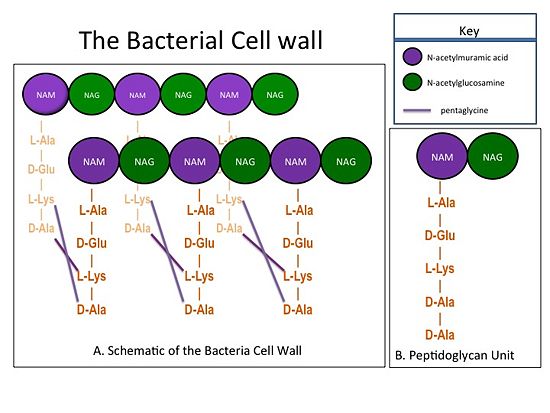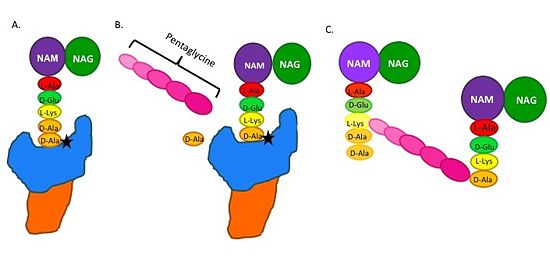Sandbox 126
From Proteopedia
(Difference between revisions)
| Line 12: | Line 12: | ||
==='''Mechanism of action of Beta-Lactam Antibiotics'''=== | ==='''Mechanism of action of Beta-Lactam Antibiotics'''=== | ||
The beta-lactam antibiotics irreversibly bind to and inhibit TPs. This results in the disruption of peptidoglycan synthesis and ultimately cell growth. Specifically, beta-lactams, such as penicillin and the anti-MRSA cephlasporins, ceftobiprole and ceftaroline, are molecular mimics of the peptidoglycan D-Ala-D-Ala moiety; the normal TP substrate (Figure 2; Tipper and Strominger, 1965). Therefore, they "trick" the TP active site serine residue to react with them, resulting in the irreversible inhibition of TP activity and of cell wall synthesis.[[Image: MechanismofPBP.jpg|thumb|alt= Alt text|Figure 2.Schematic showing Catalytic Mechanism of PBP2a (A) The peptidoglycan D-Ala D-Ala moiety enters the TP active site, which is in the TP domain (blue) (B) The active site serine residue (star) reacts with and breaks the peptide bond between the D-Ala residues. The terminal D-Ala residue exits the active site. The remaining D-Ala residue is covalently bound to the active site serine residue, and therefore, to TP. The incoming pentaglycine chain reacts with the bound D-Ala residue and is cross-linked to the D-Ala residue. (D) This results in cross-linking between adjacent peptidoglycan "sheets" and regeneration of the active site serine residue so it can catalyze another cross-linking reaction. |550px]] | The beta-lactam antibiotics irreversibly bind to and inhibit TPs. This results in the disruption of peptidoglycan synthesis and ultimately cell growth. Specifically, beta-lactams, such as penicillin and the anti-MRSA cephlasporins, ceftobiprole and ceftaroline, are molecular mimics of the peptidoglycan D-Ala-D-Ala moiety; the normal TP substrate (Figure 2; Tipper and Strominger, 1965). Therefore, they "trick" the TP active site serine residue to react with them, resulting in the irreversible inhibition of TP activity and of cell wall synthesis.[[Image: MechanismofPBP.jpg|thumb|alt= Alt text|Figure 2.Schematic showing Catalytic Mechanism of PBP2a (A) The peptidoglycan D-Ala D-Ala moiety enters the TP active site, which is in the TP domain (blue) (B) The active site serine residue (star) reacts with and breaks the peptide bond between the D-Ala residues. The terminal D-Ala residue exits the active site. The remaining D-Ala residue is covalently bound to the active site serine residue, and therefore, to TP. The incoming pentaglycine chain reacts with the bound D-Ala residue and is cross-linked to the D-Ala residue. (D) This results in cross-linking between adjacent peptidoglycan "sheets" and regeneration of the active site serine residue so it can catalyze another cross-linking reaction. |550px]] | ||
| + | |||
| + | ==='''Mechanism of Action of Beta-Lactam Antibiotics'''=== | ||
| + | The beta-lactam antibiotics irreversibly bind to and inhibit TPs. This results in the disruption of peptidoglycan synthesis and ultimately cell growth. Specifically, beta-lactams, such as penicillin and the anti-MRSA cephalosporins, ceftobiprole and ceftaroline, are molecular mimics of the peptidoglycan D-Ala-D-Ala moiety; the normal TP substrate (Figure 3; Tipper and Strominger, 1965). Therefore, they “trick” the TP active site serine residue to react with them, resulting in the irreversible inhibition of TP activity and of cell wall synthesis. | ||
| + | Figure 3. Mechanism of action of beta-lactams. A. Chemical structure of penicillin, a beta-lactam antibiotic. B. Chemical structure of the peptidoglycan D-Ala-D-Ala moiety, the normal TP substrate. C. Superimposition of the D-Ala-D-Ala moiety (red) with penicillin (black). The beta-lactams mimic the structure of the D-Ala-D-Ala moiety of peptidoglycan. This ensures TPs react with beta-lactams. | ||
| + | |||
==='''MRSA, PBP2a, and anti-MRSA Cephalosporins'''=== | ==='''MRSA, PBP2a, and anti-MRSA Cephalosporins'''=== | ||
Revision as of 18:33, 31 July 2014
| |||||||||||


